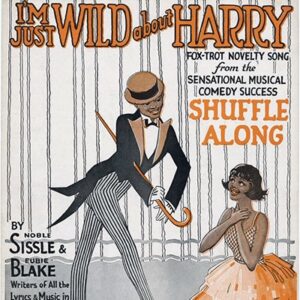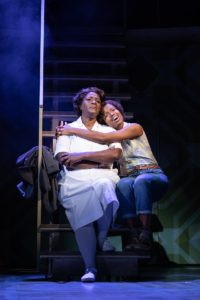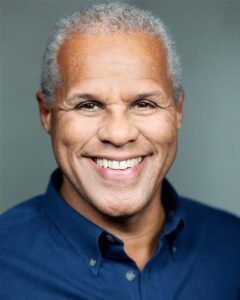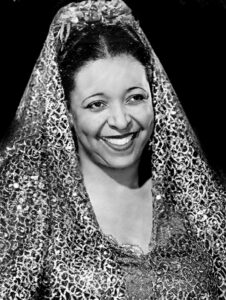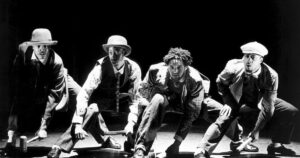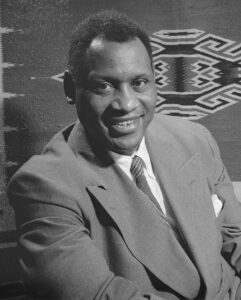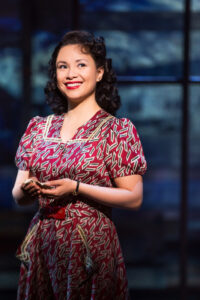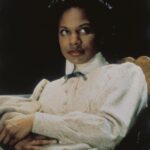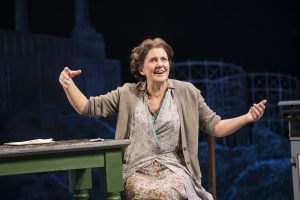Sutton Foster’s West End debut is the top
★★★★★
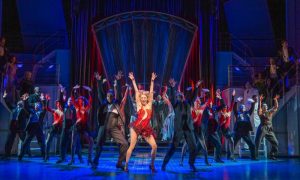
Cole Porter’s Anything Goes at The Barbican is the best musical performance I’ve seen in a long time, maybe ever. And it’s thanks to one person- Sutton Foster.
This is Sutton Foster’s first London appearance. I guess Broadway audiences know all about her qualities but in this review I’m going pick out the five key moments in which she showed she has what it takes to launch this show into the musical stratosphere. That’s not to play down the importance of Kathleen Marshall who directed and choreographed the original Broadway production and gave Sutton Foster the vehicle to show off her talent. Nor am I underestimating the support she receives from Robert Lindsay and others. And we can never forget the foundation stone of Cole Porter’s songs.
Sutton Foster very nearly didn’t appear. The part of nightclub singer Reno Sweeney was due to be played by Megan Mullally, but after she dropped out with an injury, Ms Foster- the original Tony Award-winning Reno- was drafted in. Well, Megan Mullally’s bad luck is our good fortune.
Let me set the scene. Nearly all the action takes place on the deck of a ship with interior scenes rolled on or dropped in as needed, so we nearly always have in view Derek McLane’s phallic funnels and vaginal doors and portholes, never letting us forget that this is a musical that’s at least as much about sex as romance. Then there are the parallel lines of those smokestacks which prepare us for the precision of the chorus lines.
1 She Acts
After a jolly overture in which the conductor Stephen Ridley wears a naval officer’s white hat, the top of which is picked out by a spotlight, and a short scene that kicks off the ludicrous and frankly irrelevant plot, we meet Reno Sweeney for the first time. She sings I Get A Kick Out Of You.
In modern musicals, which is to say mainly those written after Rodgers And Hammerstein changed everything, the songs are led by and enhance the story. In Cole Porter’s hey day, the 1930s, it was more a case of the story being built around the songs. So we have this classic love song, sung by Reno about young Billy Crocker. She says she’s in love with him but in no time at all she’s helping him snare the love of his life Hope Harcourt.
Even though it seems like her feelings for Billy are invented simply so she can sing this song, and even though we’ve heard it a thousand times, you very quickly realise that something extraordinary is happening here. Sutton Foster is putting in phrasing- pauses, emphases- making it personal. She’s singing like she really doesn’t understand why she has feelings for this young man. She forces this and every other song she sings (and she does have all the best songs) to mean something in the context of the show. It’s like hearing the song for the first time. Because she is acting the song.
2 She’s Funny
After Billy decides to stow away on an ocean liner bound for Britain so that he can court Hope, only to discover she is engaged to an aristocratic Englishman, Reno gives him a confidence boost. She tells him You’re The Top. It may start as Reno trying to cheer up Billy but it ends as a competition between them to find ever more bizarre compliments. So we begin with the over-the-top
‘You’re the Nile
You’re the Tow’r of Pisa
You’re the smile
On the Mona Lisa’
but end with ‘You’re broccoli.’ Now, this is a comic song but Sutton Foster takes the comedy to a new height thanks to her facial expressions: puzzlement at some of the comparisons, triumph when she finds yet another rhyme. She is indeed ‘the nose on the great Durante’.
3 She’s A Team Player
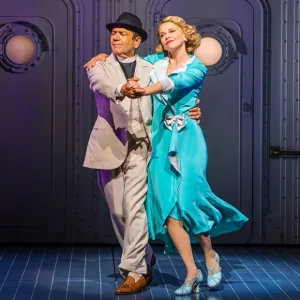
Billy and Hope, played by Samuel Edwards and Nicole-Lily Baisden, have a moment, as does Gary Wilmot, who doesn’t have a lot to do but what he does is reliably comic. Then Sutton Foster and Robert Lindsay have their only number together, Friendship. Usually, the part of Moonface Martin, a gangster disguised as a priest, is a relatively minor character in a subplot but in this production- and all credit here to the director Kathleen Marshall– he becomes a lead.
On Broadway, the great Joel Grey took the part. In London, we, and Sutton Foster, are blessed with Robert Lindsay. It sometimes seems Mr Lindsay can do anything. I last saw him extracting tears as a legendary Hollywood cameraman suffering from dementia in Prism. But of course, he is a skilled comic actor as he showed as the star of the revival of Me And My Girl. His greatest quality is his understanding of how to work an audience.
So his patter as he breaks off from the duet is pure vaudeville and transforms a comic song into comedy genius, with jokes about it being a shame Sutton Foster’s London debut is in the City of London, not the West End. And if you’re not familiar with this in-joke, it’s true that while the size of the venue and the show are ‘West End’, it is geographically speaking somewhat to the east. And what’s great about Sutton Foster is that she sails with him on this almost stream of consciousness, so that they really do seem like friends.
4 She Can Dance
The climax to the first act is the song Anything Goes. If there’s a serious theme to this musical (and there probably isn’t), it’s that standards of good and bad and right and wrong have been swept away in contemporary society, and that anyone can become a celebrity, including gangsters like Moonface Martin and Public Enemy Number One Snake Eyes Johnson, whom Billy Crocker is mistaken for, just as we find in today’s celebrity culture. This suits Cole Porter’s cynicism and gives us the song and show title.
By now, we’ve already tasted the quality of Kathleen Marshall’s choreography but this number goes up a gear. The company generates enough energy for a power station. Sutton Foster’s energy is nuclear. And so is her dancing, as she leads the synchronised stage-filling chorus through a tap routine that just builds and builds. I can’t remember when I last saw a standing ovation at the end of act one.
5 She has limitless energy
So act two opens with Reno singing Blow Gabriel Blow, a song that absolutely doesn’t fit. Why on earth would a nightclub singer sing a gospel song? Apparently, it’s because she was once an evangelist. Okay, why not? For quality of choreography and performance, it takes up where Anything Goes left off. The number starts with Sutton Foster in a preacher’s outfit but before long she and her troupe have shed their white robes to reveal red, devilishly skimpy showgirl dresses that show she also has a fantastic figure. When the dancers sway rhythmically in a close group it’s like a cauldron and again Sutton Foster, who must have been exhausted as the end of act one, is right at the centre of it, setting the stage on fire.
It’s worth remembering that the part of Reno was written for Ethel Merman and has been played in the past by luminaries such as Patti Lupone and Elaine Paige. We can add Sutton Foster to that pantheon of musical stars. Her next role is alongside Hugh Jackman in The Music Man on Broadway. I hope, after this success, we’ll be seeing more of her on this side of the Atlantic.
Those were my five moments to remember but there’s a lot more to enjoy in the production, of course. A delightful version of The Gypsy in Me in which the English Lord Evelyn Oakleigh, played by Haydn Oakley, reveals a previously unexpected passionate side leading to a comic tango with Sutton Foster, which includes an impressive vertical split from her. There’s the comedy song Be Like The Bluebird which gives Robert Lindsay a brilliant solo moment; and Carly Mercedes Dyer who recently acted everyone else off the stage as Shug Avery in the Leicester Curve production of The Color Purple gives the raunchiest version imaginable of Buddie, Beware.
Without Sutton Foster, and Robert Lindsay in support, this production would still be amusing, energetic and visually impressive but, with them, it’s the top.
Anything Goes performed at The Barbican until 31st October 2021. A return to the Barbican and a tour are planned for 2022 (with a new cast). An excellent film of the stage show is available on BBC iPlayer anythinggoesmusical.co.uk
Click here to watch the video of this review on YouTube
